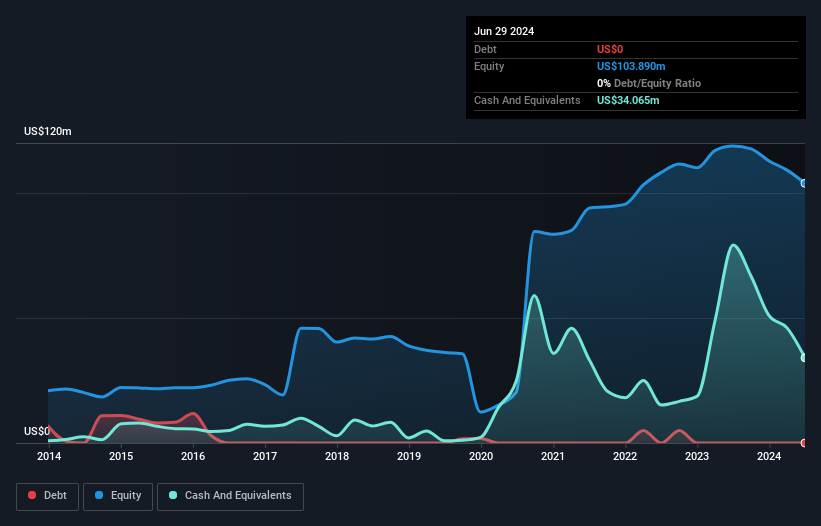- United States
- /
- Specialty Stores
- /
- NasdaqGS:PRTS
Here's Why CarParts.com (NASDAQ:PRTS) Must Use Its Cash Wisely
There's no doubt that money can be made by owning shares of unprofitable businesses. For example, although Amazon.com made losses for many years after listing, if you had bought and held the shares since 1999, you would have made a fortune. But while history lauds those rare successes, those that fail are often forgotten; who remembers Pets.com?
So should CarParts.com (NASDAQ:PRTS) shareholders be worried about its cash burn? In this article, we define cash burn as its annual (negative) free cash flow, which is the amount of money a company spends each year to fund its growth. We'll start by comparing its cash burn with its cash reserves in order to calculate its cash runway.
See our latest analysis for CarParts.com
When Might CarParts.com Run Out Of Money?
A cash runway is defined as the length of time it would take a company to run out of money if it kept spending at its current rate of cash burn. When CarParts.com last reported its June 2024 balance sheet in August 2024, it had zero debt and cash worth US$34m. In the last year, its cash burn was US$38m. So it had a cash runway of approximately 11 months from June 2024. To be frank, this kind of short runway puts us on edge, as it indicates the company must reduce its cash burn significantly, or else raise cash imminently. You can see how its cash balance has changed over time in the image below.

Is CarParts.com's Revenue Growing?
We're hesitant to extrapolate on the recent trend to assess its cash burn, because CarParts.com actually had positive free cash flow last year, so operating revenue growth is probably our best bet to measure, right now. Unfortunately, the last year has been a disappointment, with operating revenue dropping 5.7% during the period. While the past is always worth studying, it is the future that matters most of all. For that reason, it makes a lot of sense to take a look at our analyst forecasts for the company.
How Easily Can CarParts.com Raise Cash?
Given its problematic fall in revenue, CarParts.com shareholders should consider how the company could fund its growth, if it turns out it needs more cash. Generally speaking, a listed business can raise new cash through issuing shares or taking on debt. Commonly, a business will sell new shares in itself to raise cash and drive growth. We can compare a company's cash burn to its market capitalisation to get a sense for how many new shares a company would have to issue to fund one year's operations.
CarParts.com's cash burn of US$38m is about 79% of its US$48m market capitalisation. Given how large that cash burn is, relative to the market value of the entire company, we'd consider it to be a high risk stock, with the real possibility of extreme dilution.
Is CarParts.com's Cash Burn A Worry?
CarParts.com is not in a great position when it comes to its cash burn situation. Although we can understand if some shareholders find its falling revenue acceptable, we can't ignore the fact that we consider its cash burn relative to its market cap to be downright troublesome. After considering the data discussed in this article, we don't have a lot of confidence that its cash burn rate is prudent, as it seems like it might need more cash soon. On another note, CarParts.com has 3 warning signs (and 1 which makes us a bit uncomfortable) we think you should know about.
If you would prefer to check out another company with better fundamentals, then do not miss this free list of interesting companies, that have HIGH return on equity and low debt or this list of stocks which are all forecast to grow.
New: AI Stock Screener & Alerts
Our new AI Stock Screener scans the market every day to uncover opportunities.
• Dividend Powerhouses (3%+ Yield)
• Undervalued Small Caps with Insider Buying
• High growth Tech and AI Companies
Or build your own from over 50 metrics.
Have feedback on this article? Concerned about the content? Get in touch with us directly. Alternatively, email editorial-team (at) simplywallst.com.
This article by Simply Wall St is general in nature. We provide commentary based on historical data and analyst forecasts only using an unbiased methodology and our articles are not intended to be financial advice. It does not constitute a recommendation to buy or sell any stock, and does not take account of your objectives, or your financial situation. We aim to bring you long-term focused analysis driven by fundamental data. Note that our analysis may not factor in the latest price-sensitive company announcements or qualitative material. Simply Wall St has no position in any stocks mentioned.
About NasdaqGS:PRTS
CarParts.com
Operates as an online retailer of aftermarket auto parts and accessories in the United States and the Philippines.
Undervalued with adequate balance sheet.
Similar Companies
Market Insights
Community Narratives



